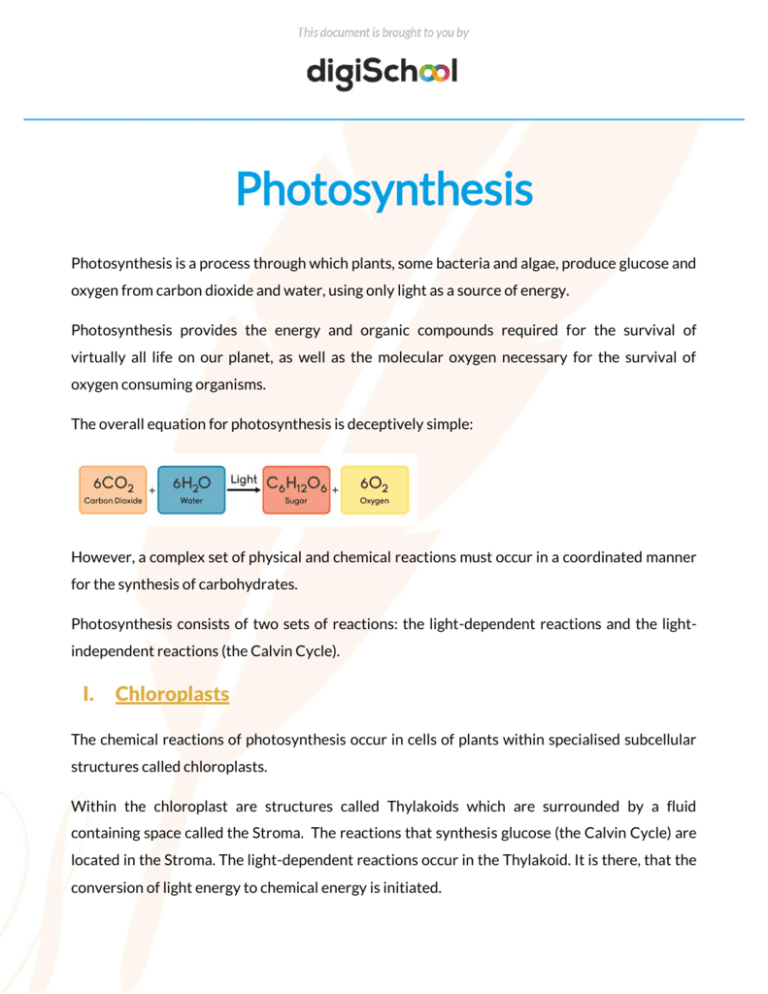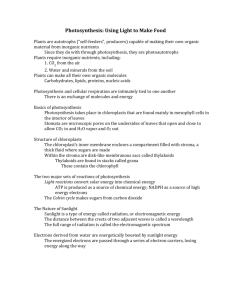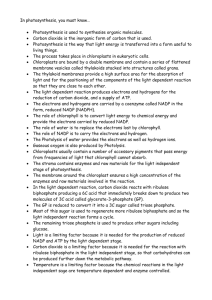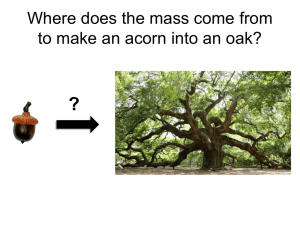Photosynthesis - Cloudfront.net
advertisement

Photosynthesis Photosynthesis is a process through which plants, some bacteria and algae, produce glucose and oxygen from carbon dioxide and water, using only light as a source of energy. Photosynthesis provides the energy and organic compounds required for the survival of virtually all life on our planet, as well as the molecular oxygen necessary for the survival of oxygen consuming organisms. The overall equation for photosynthesis is deceptively simple: However, a complex set of physical and chemical reactions must occur in a coordinated manner for the synthesis of carbohydrates. Photosynthesis consists of two sets of reactions: the light-dependent reactions and the lightindependent reactions (the Calvin Cycle). I. Chloroplasts The chemical reactions of photosynthesis occur in cells of plants within specialised subcellular structures called chloroplasts. Within the chloroplast are structures called Thylakoids which are surrounded by a fluid containing space called the Stroma. The reactions that synthesis glucose (the Calvin Cycle) are located in the Stroma. The light-dependent reactions occur in the Thylakoid. It is there, that the conversion of light energy to chemical energy is initiated. Chloroplast structure Diagram cited from: http://www.rsc.org/Education/Teachers/Resources/cfb/Photosynthesis.htm II. The light dependent stage Thylakoids contain pairs of photosystems called photosystem I and Photosystem II that work together to manufacture the energy and reducing power that will be used in the Stroma to manufacture sugars. Photosystem components of the light dependent stage(Diagram cited from: https://commons.wikimedia.or) The photosystems consist of a network of accessory pigment molecules (e.g. carotenoids) and chlorophyll - the molecule that absorbs photons of light. Within the pigment molecules the absorbed light energy excites electrons to a higher state. The photosystems channel the excited energy gathered by the pigment molecules to a reaction centre chlorophyll molecule which then passes the electrons to a series of proteins located on the Thylakoid membrane. The energised electrons are passed from the reaction centre of Photosystem II (PSII) to an electron transport chain. The electrons lost by PSII are replaced by a process called Photolysis which involves the oxidation of water to release free electrons and oxygen gas – a key byproduct of photosynthesis. As electrons are passed along the electron transport chain, the energy of the electron is used to pass hydrogen ions from the Stroma to the Thylakoid space creating a concentration gradient. This gradient powers an enzyme called ATP synthase which phosphorylates ADP to form ATP (Cyclic Phosphorylation). The low energy electrons leaving PSII move to Photosystem I (PSI). Within PS I, low energy electrons are re-energised and are passed through a second electron transport chain where they are used to reduce the electron carrier NADP+ to NADPH. When the chloroplast is harvesting a steady supply of photons, NADPH and ATP molecules are rapidly being provided to the metabolic pathways in the Stroma. In this way, the ATP and NADPH molecules produced in the light dependent reactions are used to power the Calvin Cycle reactions as illustrated below. Source :http://www3.sympatico.ca/n.rieck/images/photosynthesis-chloroplast.jpg III. Light independent stage-the Calvin Cycle The Calvin Cycle consists of a series of reactions that reduce carbon dioxide to produce the carbohydrate glyceraldehyde 3 phosphate. The cycle consists of three steps. Diagram cited from: https://www.biologycorner.com The first step is carbon fixation. In this step, Carbon dioxide is attached to Ribulose, 1,5 bisphosphate by the enzyme Rubisco resulting a six carbon molecule that splits into two, three carbon molecules 3 –phosphoglycerate (PGA). The second step is a sequence of reactions using some of the NADPH and ATP generated in the light dependent stage to reduce PGA to glyceraldehyde 3 phosphate (G3P). In the final step, Ribulose, 1,5 bisphosphate is regenerated. For every 5 turns of the cycle 3 molecules of G3P is used to reform 3 molecules of Ribulose, 1,5 bisphosphate. The remaining G3P is used to make glucose, which provides a starting point for the manufacture of other organic compounds such as fatty acids, starch and cellulose. MCQ 1. Name the carbon dioxide acceptor in photosynthesis? a) Ribose Phosphate b) Ribulose bisphosphate c) RBP d) Ribophosphate 2. Which of these is not a product of the light dependent stage? a) Oxygen b) ATP c) NADHP d) ADP 3. What is the purpose of cyclic phosphorylation? a) To add phosphate to the glucose made in photosynthesis b) To make ATP without using the glucose made in photosynthesis c) To recycle electrons d) To absorb light energy 4. Which of the following is not a pigment in photosynthesis? a) Chlorophyll b) NADPH c) Xanthophyll d) Phaeophytin 5. Where does the Light-independent stage of photosynthesis occur? a) Grana b) Thylakoids c) Cytoplasm d) Stroma 6. What happens to the electrons displaced from PSII? a) Used to reduce NADP? b) Carried along the chain of electron carriers to PSI c) Carried along the chain of electrons to PSII d) Used to split water 7. What are the products of the Light Dependent stage? a) Oxygen, reduced NADP, ADP and phosphate b) Oxygen, reduced NADP and ATP c) Oxygen, reduced NADP and glucose d) Glucose, reduced NADP & ATP 8. Where are chlorophyll molecules located? a) Stroma b) Thylakoid membranes c) Outer membrane of the chloroplast d) Cytoplasm 9. As electrons pass along the first electron carrier chain in the Light dependent reaction what is their energy used for? a) To replace electrons lost from PSI? b) To split water c) To reduce NADP d) ATP synthesis 10. Which chemicals are produced in the Light Independent reaction? a) Reduced NADP, ADP & phosphate, Glucose b) NADP, ATP, Glucose c) NADP, ADP & phosphate, Glucose d) NADP, oxygen, Glucose ANSWERS 1b 2d 3b 4bd 5d 6b 7b 8b 9d 10c









